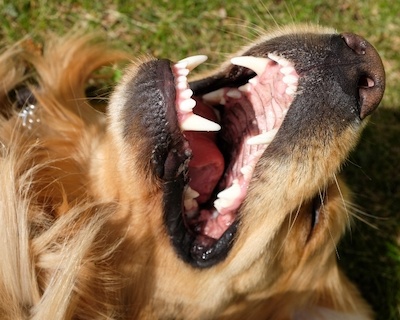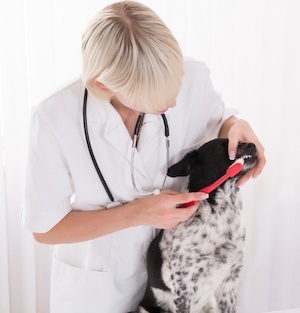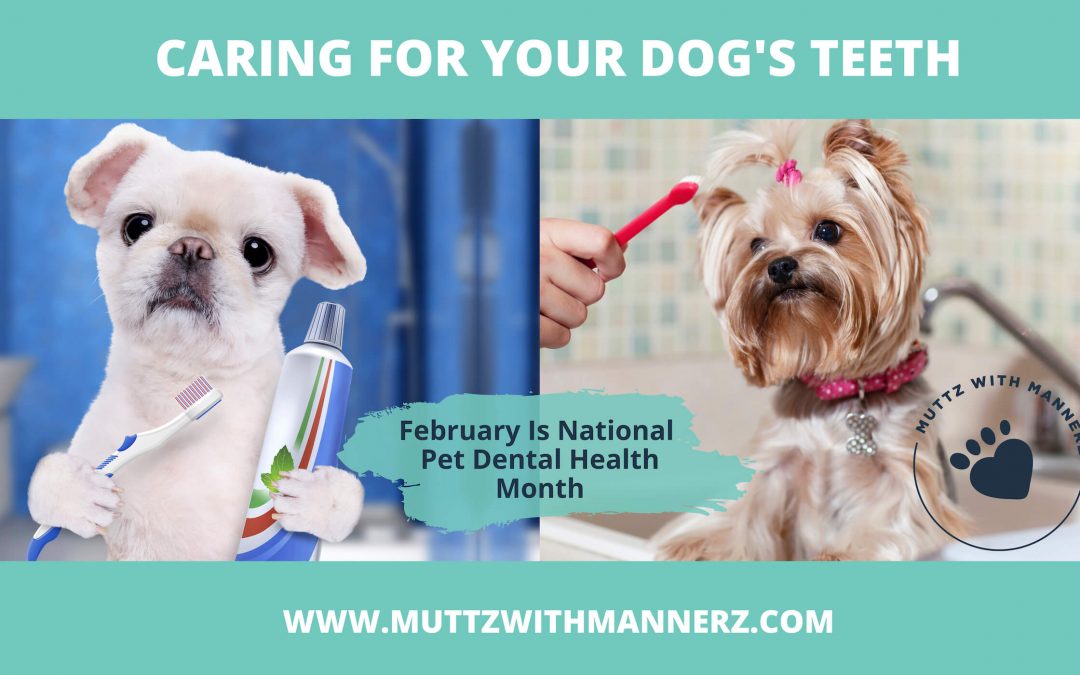February is National Pet Dental Health Month
How do you care for your dog’s teeth?
Just like humans, dogs have teeth that need to be cared for – do you know how to do this effectively and what’s involved?
Many pet owners know little or nothing about those teeth – other than they can bite – but they should also understand the importance of brushing them regularly.
Most animals (including humans) have teeth that reflect the food we eat. The main purpose of teeth is for grinding food that is eaten. Dogs’ teeth are not as sharp as cats’ teeth, but their teeth and jaws are much stronger.
 Adult dogs have approximately 42 teeth, though our genetic manipulation of the species has resulted in dogs with fewer or more. They have six incisors (front teeth) on the top jaw and six on the bottom; two canine teeth (the largest “fangs”) on the top and two on the bottom; eight premolars on the top and eight on the bottom; and two molars on the top and three molars on the bottom.
Adult dogs have approximately 42 teeth, though our genetic manipulation of the species has resulted in dogs with fewer or more. They have six incisors (front teeth) on the top jaw and six on the bottom; two canine teeth (the largest “fangs”) on the top and two on the bottom; eight premolars on the top and eight on the bottom; and two molars on the top and three molars on the bottom.
The dog uses their front teeth – the smallest and most fragile teeth – for their most delicate operations. They use these teeth to groom themselves and pull burrs and insects from their skin and coat. They also use them when scraping edible tissue from the surface of bones or as they evolved stripping the “fuzz” off of tennis balls which we don’t recommend as a matter of safety.
Did you know that most of a dog’s chewing action is provided by the premolars? The molars, located at the far back of the mouth – where the dog has the most jaw strength, like the base of a pair of pliers – are mostly used only for extreme crunching.
Canine teeth can also help us estimate the age of a young dog, but after they are about eight months old and have all their adult teeth, we have to use other clues to estimate age, such as the amount of staining, wear, and accumulation of tartar on the teeth.
Here’s what most dog owners really want to know about their dogs’ teeth: “Do I really have to brush them?”
Although veterinary dental specialists would prefer that all owners brush their dogs’ teeth, the fact is that some dogs need it more than others. Whether it’s due to their genes, diet, chewing habits, and/or the chemical composition of their saliva, some dogs go to their graves with clean, white teeth and healthy gums with absolutely no effort put forth by their owners. Others develop tartar (also known as calculus) at an alarming rate.
The accumulation of plaque and tartar is not just unsightly, it’s unhealthy. Tartar buildup at and under the gum line enables the entrance and growth of bacteria under the gums. Most dogs who have bad breath also have gingivitis – swollen and inflamed gums, usually bright red or purple, and which bleed easily. Unchecked, these bacterial infections in the gums can slowly destroy the ligament and bony structures that support the teeth (periodontitis).
 Taking care of your dogs’ teeth and gums is important for their entire well-being. Because of the ample blood supply to the gums, infections in the mouth can also poison the dog systemically, potentially causing disease of the heart, kidneys, and/or liver.
Taking care of your dogs’ teeth and gums is important for their entire well-being. Because of the ample blood supply to the gums, infections in the mouth can also poison the dog systemically, potentially causing disease of the heart, kidneys, and/or liver.
If your dog’s teeth are free of plaque or tartar, and the gums are tight and free of any signs of inflammation, you are one of the lucky ones. If, however, their gums are noticeably redder at the gum line and they have any visible tartar buildup on their teeth, you need to first have their teeth cleaned by a veterinarian. Once this is done you can maintain the health of their teeth and gums with regular brushing and periodic veterinary cleaning.
If you are one of the unlucky ones, and your dog’s teeth and gums need your intervention to stay healthy, how often do you really need to brush your dog’s teeth?
Put it this way: the more you brush, the less frequently you’ll need to pay for a veterinary cleaning.
Tips on brushing your dog’s teeth:
- If you haven’t brushed your dog’s teeth before start slow. Use a circular motion, gently scrubbing plaque away from the gum line. Do a few teeth each day. Reward your dog frequently and richly with treats and praise.
- We recommend very soft-bristled brushes with long handles, so you can make sure you reach the molars. There are finger brushes, but they don’t tend to work as well, and there is the chance your dog can bite your finger. For larger dogs, soft brushes meant for adult humans work fine; baby human toothbrushes work well for smaller dogs.
- Use an enzymatic toothpaste designed for dogs. They come in flavors that are meant to appeal to dogs (chicken or beef). They are free of fluoride which can be toxic to dogs. Look for products that contain antibacterial enzymes, which help discourage bacterial growth and avoids the resulting gingivitis.
- Dip the brush in water frequently as you brush. This helps to rinse the plaque away from your dog’s teeth and facilitates a thorough application of the antibacterial enzymes in the toothpaste.
By starting early and getting your dog used to this procedure of brushing their teeth may prevent the need for Dentistry by a Veterinarian which can be quite expensive.
After all this, you’ll probably be motivated to give that tooth brushing a try. Do it now, while you’re good and motivated; it could add years to your dog’s life.

